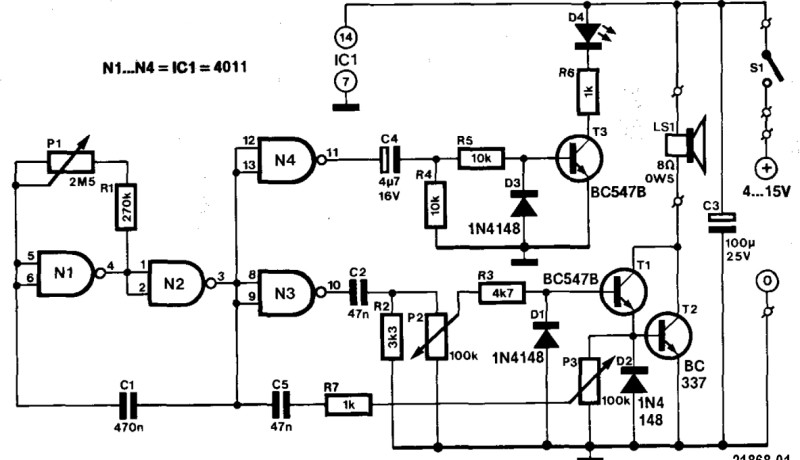Small Circuits Revival (18): Electronic Metronome

Electronic Metronome
idea: Elex Team
With that ‘double tick’ we mean that the sound generated by those mechanical metronomes is not a sterile tick-tick-tick, but are more like the tick-tock-tick-tock not unlike an old pendulum clock, which many musicians find much more pleasant to the ear.
A nice feature of this circuit is that the volume of the ‘tick’ and that of the ‘tock’ can be set independently of each other.
The heart of the circuit (Figure 1) is formed by a squarewave generator around two CMOS NAND gates N1 and N2, from a (CD)4011 IC . The frequency of the generated squarewave is set on potentiometer P1.
The squarewave output signal (which, by the way, has a duty cycle of 50%) from this generator (pin 3 of N2) goes down three paths. Firstly, the squarewave is inverted by N4, differentiated by C4/R4 and finally made visible with the aid of T3 and LED D4.
Secondly, the squarewave passes through inverter N3 and differentiator C2/R2/P2 to arrive, via the volume control pot, at the base of a discretely-built Darlington T1/T2. This combination of transistors provides considerable gain to the output pulse from the differentiator, which results in a very loud ‘tick’ from the loudspeaker.
And thirdly, the squarewave passes non-inverted through a third differentiator and via potentiometer P3 goes to the base of T2. Because this signal (the ‘tock’) is amplified by only one transistor and not the entire Darlington combination, this ‘secondary tock’ is not as loud as the ‘main tick’: TICK-tock-TICK-tock-...
This construction of this circuit on a piece of prototyping stripboard or breadboard should not cause any difficulties; use a socket for the 4011 IC and handle its with care: while the latest generation of CMOS ICs are not extremely vulnerable, they are nevertheless still more sensitive to electrostatic discharges than ‘normal’ semiconductors.
